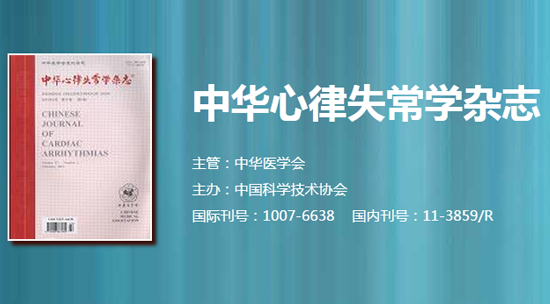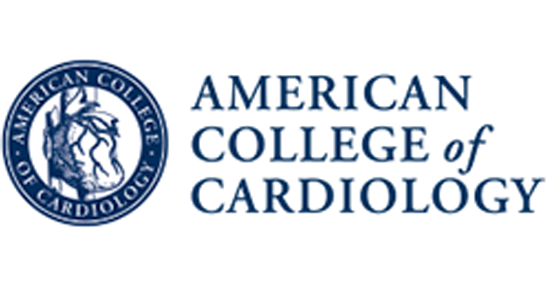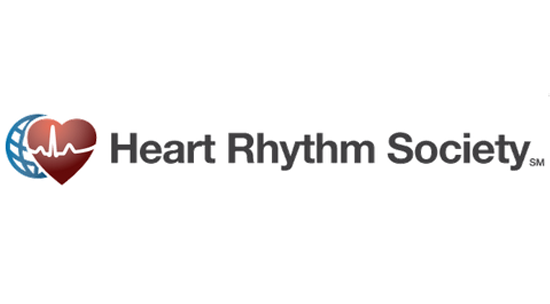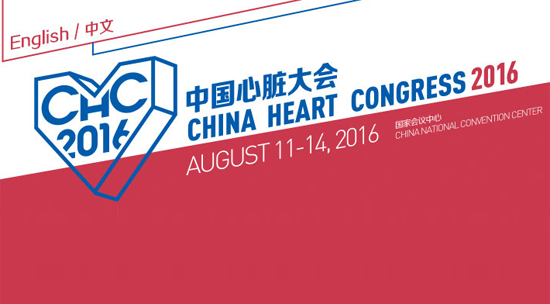HeartRhythm主编—陈鹏生教授语音速递(三月刊 英文版)
<< First issue in March 2020 >>
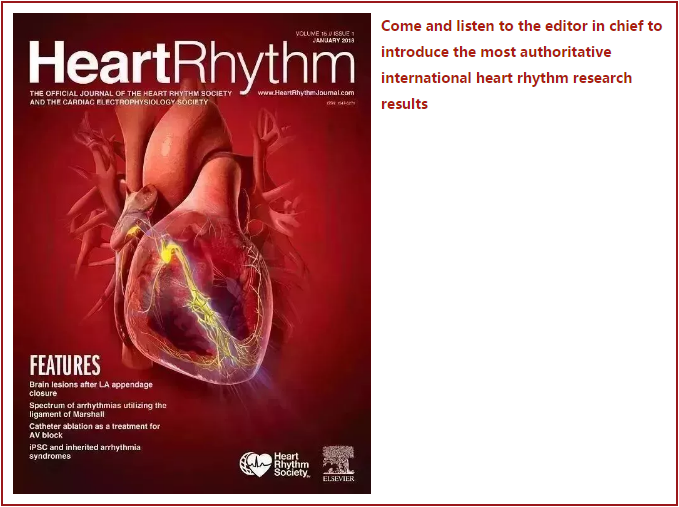

1
The featured article this month is “Sudden Cardiac Death Risk Prediction in Heart Failure with Preserved Ejection Fraction” by Adabag et al. A comprehensive interview with the senior author, conducted by our online editor, Dr. Daniel Morin, can be found at the www.heartrhythmjournal.com website. Sudden cardiac death comprises 25% of the deaths in heart failure with preserved ejection fraction or HFpEF. The authors followed about 3500 patients for 3 years. They found that age, sex, myocardial infarction, diabetes mellitus, bundle branch block, NT pro-BNP levels can identify patients with HFpEF who had a high risk of SCD. These findings may be used to identify patients for a sudden cardiac death intervention trial in HFpEF.
2
The next article is titled “Bodyweight fluctuation is associated with increased risk of incident atrial fibrillation” by Lee et al. The data came from a nationwide population- based cohort of 8 million adults from the Korean National Health Insurance Service database without a history of AF. During median 8.1 years of follow-up, the authors found that bodyweight fluctuation was independently associated with an increased risk of AF development, especially in individuals with low bodyweight, and regardless of weight gain or loss. These findings may be important to designing weight management program to avoid fluctuations of body weight.
3
Coming up next is a paper by Vuddanda et al titled “Incidence and Causes of In- hospital Outcomes and 30-day Readmissions After Percutaneous Left Atrial Appendage Closure: A United States Nationwide Retrospective Cohort Study Using Claims Data”. Among 5500 patients studied, the in-hospital mortality was 0.3%. Endocardial Left Atrial Appendage Closure had lower complications and 30-day readmissions but higher hospitalization cost than epicardial Left Atrial Appendage Closure. The most common reason being pericarditis and effusion associated with epicardial approach. However, given recent improvements in epicardial Left Atrial Appendage Closure technique, there is a significant reduction in pericardial complications. These data suggest that more recent data will be needed to compare the rate of complications between endocardial and epicardial techniques.
4
Keller et al wrote the next paper titled “Impact of atrial fibrillation/flutter on the in- hospital mortality of ischemic stroke patients”. The data came from 3 million patients in the nationwide German inpatient sample of the years 2005-2015. Overall, 9.0% of the stroke patients died in-hospital. The case fatality rate increased with growing age and was higher in stroke patients with than without AF. These findings indicate that AF was an important predictor for in-hospital death and adverse events during hospitalization independently of age, sex and comorbidities.
5
The next paper is titled “Prospective comparison of periprocedural coagulation markers among uninterrupted anticoagulants for atrial fibrillation ablation” by Nagao et al. In total, 275 consecutive patients who underwent AF ablation were evaluated for fibrin monomer complex level and the prothrombin fragment 1+2 levels.They found that these levels during the periprocedural period of AF ablation was higher in the dabigatran group than in rivaroxaban, apixaban, edoxaban or warfarin groups. Furthermore, dabigatran use independently predicted the occurrence of silent stroke. A possible explanation is that dabigatran mainly affects the intrinsic clotting system by direct inhibition of thrombin, while rivaroxaban, apixaban, and edoxaban inhibits both the extrinsic and intrinsic clotting systems.
6
Coming up is a paper by Schaeffer et al, titled “Characteristics of Myocardial Tissue Staining and Lesion Creation with an Infusion-Needle Ablation Catheter for Treatment of Ventricular Tachycardia in Humans”. In 25 patients intramural ablation of VT was performed with a needle catheter. Fluoroscopic images of myocardial staining patterns at 155 sites produced by pre-RF saline/contrast infusion were analyzed. The authors found that with infusion-needle ablation, pre-ablation injection of contrast can help confirm an intramural position and predict lesion creation. The findings also have implications for the injection of therapeutic agents into regions of scar to ablate intramural substrate of VT.
7
The next article is “Ventricular Arrhythmia Risk Prediction in Repaired Tetralogy of Fallot using Personalized Computational Cardiac Models” by Shade et al. The authors generated patient-specific computational heart models of the repaired Tetralogy of Fallot. Simulations of rapid pacing determined VT inducibility. Two patients in the study experienced clinical VT. The virtual hearts predicted correctly reentrant VT in the models from VT-positive patients and no arrhythmia in those from VT-negative patients. This study demonstrates the potential of the image-based virtual-heart modeling methodology to improve VT risk stratification in patients with repaired Tetralogy of Fallot. Further studies will be needed to show the same in patients with VT due to other structural heart diseases.
8
Lloyd et al wrote the next article titled “Clinical Experience of Stereotactic Body Radiation For Refractory Ventricular Tachycardia in Advanced Heart Failure Patients”. Stereotactic body radiation therapy, abbreviated as SBRT has been shown to be effective in treating patients with refractory VT. The authors studied SBRT outcomes in 10 patients with advanced heart failure. The SBRT reduced total ICD shocks by 68%, but there is one non-responder. These findings suggests that SBRT treatment may be a useful palliation for electrical storm. While most of the patients received sympathetic blockade, it was unclear if propranolol was used. Whether or not SBRT is more effective than propranolol in managing patients with electrical storm remains unclear.
9
The next paper is titled “Risk stratification in patients with frequent premature ventricular complexes in the absence of known heart disease”, written by Ghannam et al. The authors studied 272 patients. Delayed enhancement CMR found scar in 67 patients. Seven patients were found to have inducible VT. The presence and amount of the scar were related to the risk of long-term VT independent of EF, with hazard ratio of 18.8. The positive predictive value and negative predictive value inducible VT during long-term follow-up were 71% and 100%, respectively. These two preprocedural testingcan be used to identify patients with frequent PVCs without apparent heart disease who are at risk for VT. These data are important in risk stratifying patients with PVCs.
10
Chen et al wrote the next article, titled “Simple Electrocardiogaphic Criteria for Rapid Identification of Wide QRS Complex Tachycardia: the new Limb Lead Algorithm.” The algorithm include the following: (1) monophasic R wave in lead aVR; (2) predominantly negative QRS in leads I, II, III; and (3) concordant monophasic QRS complex in all three inferior leads; AND concordant monophasic QRS complex in two or three of the remaining limb leads with an opposite polarity to that of the inferior leads. The authors used this algorithm to differentiate VT from SVT in 528 wide complex tachycardia cases. They found that these criteria are simple and accurate in differentiating VT from SVT. A benefit of this algorithm is that only limb leads are required to make the diagnosis.
11
Next up is a paper titled “Direct and Indirect Mapping of Intramural Space in Ventricular Tachycardia” by Bhaskaran et al. The authors mapped 16 patients during open heart surgery and 16 explanted heart during Langendorff perfusion. The intraoperative mapping showed predominant endocardial activation was present in 10/18 VTs (55%). In 8/18 VTs (44%) the VT circuit was presumed to be intramural. In explanted hearts, VT location was predominantly intramural in 8/19, or 42%. These findings show that in a significant proportion of both ischemic and non-ischemic VTs the predominant activation was located in the intramural space. This finding may have significant implications in mapping and ablation of VTs.
12
Zeitler et al wrote the next paper, titled “Complications Involving the Subcutaneous Implantable Cardioverter Defibrillator”. The data came from FDA’s Manufacturer and User Facility Device Experience database. The authors found 1604 events over 24 months. There were 542 instances of infection with system removal reported in 414 (77.5%). Inappropriate shocks occurred in 550 patients, and 382 (69%) were attributed to oversensing. There were 15 deaths. Among them, 11 were device related. The authors conclude that several S-ICD complications appear to be related to the ICD’s design and function over time. A better understanding of these complications may help inform patient selection, implant technique, and post-implant management.
13
The next paper is “Defibrillation failure in patients undergoing replacement of subcutaneous ICD pulse generator” written by Rudic et al. The authors studied 25 consecutive patients underwent S-ICD replacement between 2015 and 2019. Among them, the first or second 65J shock following pulse generator replacement failed to defibrillate in 5 patients (20%). Repositioning of the pulse generator and/or capsulectomy at pocket site were necessary to achieve effective DFT with 65J in all cases. The authors conclude that a high proportion of patients had DFT failure after S- ICD pulse generator replacement. These findings indicates that DFT testing is mandatory to ensure safe function of the S-ICD.
14
The next article is titled “Changes in global electrical heterogeneity associated with dofetilide, quinidine, ranolazine, and verapamil”, written by Stabenau et al.Vectorcardiographic global electrical heterogeneity is to be associated with ventricular arrhythmias and sudden death. The authors studied effects of antiarrhythmic drugs on that measurement. They found that dofetilide and quinidine were associated with significant changes in more global electrical heterogeneity parameters compared with verapamil and ranolazine. These changes, which differ by sex, are likely driven by alterations in ion channel function and dispersion of depolarization or repolarization. Vectorcardiographic global electrical heterogeneity measurement may allow early assessment of favorable or adverse antiarrhythmic drug effects.
15
Zhang et al wrote the next article titled “Utilization of Implantable Cardioverter Defibrillators for Prevention of Sudden Cardiac Death in Emerging Countries” The authors reported the results of Improve SCA Clinical Trial, which is a prospective study to evaluate the benefit of ICD therapy in underrepresented geographies. A total of 3889 patients were included in the analysis to evaluate VT or VF therapy and mortality rates. The study patients had predominantly nonischemic cardiomyopathy. There was a 49% relative risk reduction in all-cause mortality in ICD implanted for primary prevention with specific risk factors that include syncope, nonsustained VT, PVC>10/h, and LVEF< 25%. These data indicate that the mortality benefit of ICD therapy extends to a selected primary prevention population from underrepresented geographies.
16
Next up is “Standard Bipolar Voltage Amplitude Criteria Underestimates Myocardial Scar During Substrate Mapping with a Novel Microelectrode Catheter” by Lee et al. Low voltages measured by mapping catheters correlate with dense scar and border zone. However, those criteria were established using a 3.5 mm tip catheter. it is unclear if standard voltage criteria apply to catheters with smaller electrode size and interelectrode distance. The authors used swine model to perform the study. They found that bipolar voltage values acquired from microelectrodes are systemically larger than those acquired from standard catheters. New reference values should be established for the newer mapping catheters with multiple small electrodes and tighter interelectrode distances.
17
Jain et al wrote the following article titled “Sustained Quality of Life Improvement Post-Cryoballoon Ablation in Patients with Paroxysmal Atrial Fibrillation”. The data came from 335 subjects in STOP-AF Post-Approval Study. Both physical and mental quality of life composite scores increased significantly from baseline. All arrhythmia symptoms significantly decreased from baseline after ablation. The authors conclude that Cryoballoon ablation for the treatment of paroxysmal AF results in a significant, and sustained, quality of life improvement probably related to the reduced arrhythmic burden. The limitation of the study is the absence of a randomly assigned control group for comparison.
18
The next article is titled “High-throughput phenotyping of heteromeric human ether- à-go-go-related gene potassium channel variants can discriminate pathogenic from rare benign variants” written by Ng et al. The authors expressed the KCNH2 variant in human embryonic kidney 293 cell lines and phenotyped using an automated patch-clamp platform and a cell surface ELISA assay. They found that these high-throughput electrophysiological phenotyping of heterozygous KCNH2 variants can accurately distinguish between dominant-negative, haploinsufficient loss-of-function, and benign variants. This assay may help with future classification of KCNH2 variants. A limitation is that the human embryonic kidney 293 cell line does not reproduce the intracellular signaling pathways that are present in cardiac myocytes. Therefore, more studies are needed to document the validity of these methods.
19
The final research article is written by Greer-Short et al, titled “Calmodulin kinase II regulates atrial myocyte late sodium current, calcium handling and atrial arrhythmia”. Atrial myocyte electrophysiology, calcium handling, and arrhythmia susceptibility were studied in wildtype and Scn5a knock-in mice expressing phosphomimetic or phosphoresistant Nav1.5, which is the sodium channel protein. The results of the study help the authors identify CaMKII-dependent regulation of Nav1.5 as an important upstream event in calcium handling defects and abnormal impulse generation in the setting of AF. This study further highlight the importance of CaMKII in cardiac arrhythmogenesis.
In addition to the above original articles, the journal published a Historical Vignette by Maron et al titled “The Guidant Affair Revisited...But This Time With Good News”. We also added a Pediatric and Congenital Electrophysiology News as one of the EP News articles. I hope you enjoyed this podcast. For Heart Rhythm, I’m Editor-In- Chief, Dr. Peng-Sheng Chen.
